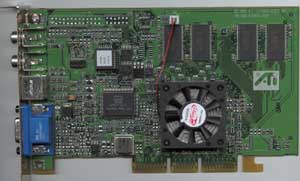Clock Speed
The original Rage 128 ended up with a shipping core clock speed of around 100MHz (103 - 105MHz is what we found in our lab), while OEMs received parts that were clocked at 90MHz (like the TNT at the time) and featured no heatsink. The memory clock of the original Rage 128 was also around that 100MHz mark, even on OEM boards, placing the final clock speed for Rage 128 boards at ~100/100MHz for retail products at 90/100MHz for OEM boards.
Following in the footsteps of 3dfx, NVIDIA, and S3, ATI decided to use the greater yields they've had on the chips in order to bump up the clock speed. From our conversations with ATI it seemed like the 133/133MHz mark was what they were aiming for with the Rage 128 Pro. However, we've received conflicting reports as to what the actual clock speed of the shipping boards will be. ATI, like Matrox, has a policy of not disclosing the clock speeds of their parts but basic mathematics can help us identify what the actual clock speeds are.
We received word that the final shipping Rage 128 Pro chips would be running at a clock speed of 125MHz, identical to that of NVIDIA's TNT2. This conflicted with what PowerStrip revealed to us on our review sample which indicated a 143MHz core clock speed. A quick call to ATI gave us the response we expected, "We don't usually disclose clock speeds" but at the same time they also confirmed that our review samples were running at the same frequencies the final shipping (retail) products would be running at. Regardless of what this frequency is, the bottom line is that the benchmarks you'll see in our review will be representative of the performance that the card you'll be able to go out and buy will provide you with.
Our review sample was outfitted with 6ns Samsung SDRAM which is theoretically capable of running at up to 166MHz, making PowerStrip's reported 155MHz frequency a very reasonable estimate. This 155MHz frequency is just 5MHz above what ATI hinted the board should be clocked at but, the discrepancy is worth noting.
The note to make here is that this positions the Rage 128 Pro at an almost identical clock speed to the TNT2 but slightly under that of the TNT2 Ultra so you should theoretically be able to expect gaming performance around the level of a TNT2. Does this mean that the TNT2 just gained a head to head competitor? Better late than never…
Memory & AGP 4X
With the issue of clock speed out of the way, very little separates the Rage 128 Pro from the original Rage 128. The Pro can support up to 32MB of SDRAM and the chip itself supports SGRAM as well as Double Data Rate (DDR) SGRAM but you won't see anything more than the standard 32MB SDRAM configuration for quite some time on Rage 128 Pro boards. The memory bus is still 128-bits wide, which is nearing its limits because 32-bit color rendering puts an even greater stress on memory bandwidth.
The chipset is fully AGP 2X and 4X compliant and although the current performance benefit is next to nothing it is nice to know that the support is there. This does not mean that the board will not function if you don't have an AGP 4X compliant slot, it only means that you won't be able to gain the advantages of AGP 4X's increased transfer rates, which currently offer an average performance increase of about 0.9% (that's nine tenths of a percent). In the future this will probably change, but for now the feature brings you no performance gains or penalties.











0 Comments
View All Comments